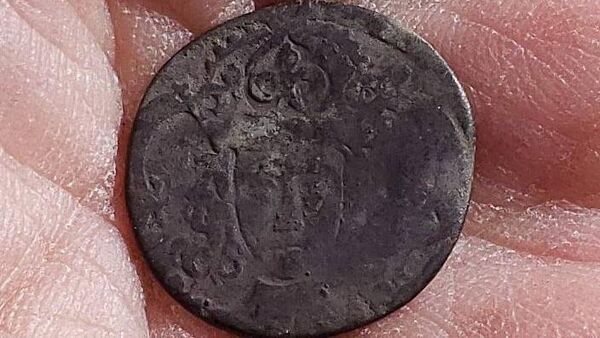1,000-year-old coin among finds in Cork archaeological dig
The discovery of the coins has fuelled speculation that a castle may have stood on this site much earlier than expected

Two silver coins, one almost 1,000-year-old, and a tax token which was later used as a board game piece during the Middle Ages have been unearthed during archaeological excavations as part of the multi-million restoration of a landmark tower house.
The discovery of the coins by archaeologist Tony Miller, who is excavating the medieval Carrignacurra castle near Inchigeela in Cork, has fuelled speculation that a castle may have stood on this site much earlier than expected.

The ‘jeton’ or chequer piece, used for accounting and later as gaming pieces, has been unearthed following excavations at Carrignacurra Castle in Cork.
The tower house, which dates from around 1570, was one of three such tower houses built by the O’Learys. It is the only one left standing.
It was built on a high rock outcrop to defend an important ford on the river Lee, and was originally the seat of the O’Leary family before it was captured by the O’Sullivan clan and eventually fell derelict.
Its most recent owners made a start on renovations but abandoned the work before it was finished.
American owners
The imposing protected structure was bought last year by an American couple, Shawn and Tom Carlson, both pilots, who embarked on an ambitious €2m restoration project.
Ms Carlson, née O’Leary, is a direct descendant of Cornelius Ó Laoghaire, who fled to America in 1773 after he fatally shot the sheriff, Morris, to avenge the death of his brother, Art Ó Laoghaire who was immortalised by his widow, Eibhlín Dubh Ní Chonaill, in the epic Irish lament, Caoineadh Airt Uí Laoghaire.
The Carlsons hosted a site visit of around 75 people who were in the Lee Valley this month to attend the O’Leary clan gathering.
Mr Miller, who briefed them on the archaeological finds, told the Irish Examiner that his excavations have been concentrated around the tower base and the ground floor.
“During the excavation of the ground floor, a cobbled floor was uncovered in one corner as well as a rectangular base for storage bins or a workbench against the northern wall,” he said.
Pipes and pottery
He has unearthed clay pipes, one of which was made in Bristol, leading to speculation that it could have been left by Cromwellian troops when Roger Boyle knocked the castle under orders from Cromwell, as well as a small amount of domestic pottery dating from around the 16th century, animal bones, mostly pig bones, a small bone bead and lead musket balls, mostly unused, with evidence that they were being made on site.
But among the most interesting finds were two silver coins — one known as a groat featuring Henry 111 and dated to 1270, and the other featuring Edward IV, dating from the 1470s.

A musket and pistol ball with a small ingot of lead was found during excavations at Carrignacurra Castle in Cork.
Mr Miller said this coin was uncovered at a level near bedrock at the very foot of the castle and is a century older than the generally accepted date of the tower house.
But he said the most unusual find was an exchequer piece or ‘jeton’, made in Bavaria around 1620, which was commonly used for calculating taxes, and which was later used as a board game piece in the Middle Ages equivalent of draughts.
The token carries a motto with a religious reference meant to keep the user honest. One of the clay pipes, dated to the first half of the 17th century. It dates from a time when tobacco was expensive and therefore features a small bowl.

Only a handful of these tokens have ever been found in Ireland. They are usually found in Britain nearer to London.
The finds feature in one of Cork County Council’s latest heritage books.
Mr Miller said further excavations will be undertaken on what is presumed to be a medieval ramp and wall on the south side of the castle, as well as carbon dating remnants of basket weave used to create the vault on the interior of the structure.
